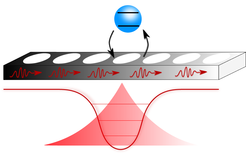One impurity to bind them all
MPQ researchers show that a single atomic impurity is able to trap infinitely many bosons around it.
Nobody is perfect, but sometimes it is the defect that makes the difference. For example, the electric properties of semiconductors undergo significant changes by the slightest variation in the dopant concentration, and though a perfect diamond is without any colour, atomic impurities make them shine in pale blue, violet or pink which even enhances their value. All these effects go back to processes that are triggered by the interaction of the impurity with the quantum many-body system it is embedded in. A team of physicists in the Theory Division of Prof. Ignacio Cirac at the Max Planck Institute of Quantum Optics (MPQ) has now investigated the more general case where an impurity atom is coupled to a structured bath of bosons (for example, photons in a periodically engineered dielectric) showing how a single atom can bind many bosons around it. Bound states of bosons are of particular interest because they give rise to long and strong interactions enabling new regimes for quantum simulations. (Phys. Rev. X 6, 021027 (2016), 25 May 2016).

The interaction of spin impurities with bosonic reservoirs lies at the heart of very paradigmatic models in Quantum Optics and Condensed Matter and gives rise to very rich phenomena. For example, in the context of atoms coupled to engineered dielectrics, i.e., photonic crystals, it was predicted that a single atom can localize a single-photon cloud around it if the atomic frequency lies in the photonic bandgap of the material. With the recent advances in interfacing atomic systems with photonic crystal structures, these atom-photon bound states have experienced a renewed interest in the context of quantum simulation as they have been proposed to mediate strong and long-range interactions between atoms.
In their newly published work, Tao Shi, Ying-Hai Wu and Alejandro González-Tudela from the Theory Division of Prof. Ignacio Cirac study the general problem of a single spin impurity coupled to a generic bosonic bath and show that a single atom can indeed trap not a single, but infinitely many bosons around it. Loosely speaking, the coupling of the impurity to the bath generates an effective potential to the bosons that is able to localize the bosons around it. In particular, a single atom can localize a multi-photon cloud around it within a photonic crystal. Moreover, the authors also provide a variational description that allows them to describe their behaviour in all parameter space, unveiling the existence of many different regimes with different scaling of physical properties like the energy or the size of the bound states.
Due to the generality of the model, these bound states can potentially be prepared and observed in many different platforms, ranging from atoms coupled to photonic crystals to circuit QED or even cold atoms in state dependent optical lattices. The existence of these boson bound states spans the possibilities of these platforms to simulate new exotic many-body phenomena. [AGT/OM]












